

Want to speak Spanish like a native? You need more than just basic words and phrases. So, try using Spanish idioms. They make you sound fluent. These idioms are special sayings used by native speakers that don’t always make sense when translated directly.
In this article, we’ll show you how 300+ common Spanish idioms to talk like a native speaker enhance your Spanish fluency. At the end, you will get a free booklet so you can have something more than expected.
This way, you will understand Spanish culture better and make your conversations more natural.
Plus, you’ll impress your friends and feel more at ease when talking in Spanish. So, let’s get started and make you sound like a native Spanish speaker!
Understanding Spanish Idioms
Spanish idioms are set phrases that have meanings not easily understood from the individual words. These idioms often mean something different than what the words literally say.
Learning these idioms helps you speak Spanish more fluently and get to know the culture better. If you love language, you may already know some Spanish idioms. But there are many more you can learn to improve how well you speak.
What’s great about Spanish idioms is how varied they are. They come from different regions and countries where people speak Spanish.
Using these idioms when you talk makes you sound more like a native speaker. It also helps you connect better with people who speak Spanish.
Literal vs. Figurative Meanings of Spanish Idioms
Comprehending the distinction between literal and figurative meanings is a key aspect of learning Spanish idioms. The literal meaning is the exact translation of the words, while the figurative meaning is the real significance when used in a sentence.
Another popular Spanish idiom is “La curiosidad mató al gato,” which literally translates to “Curiosity killed the cat”. In this case, the figurative meaning is similar to the English idiom, advising against being too nosy about things that don’t involve you.
Understanding the contrast between literal and figurative meanings enhances your ability to use Spanish idioms in conversation and appreciate their cultural significance.
Top 10 Spanish Idioms to Master
We’ve compiled a list of 10 pivotal Spanish idioms to assist you in sounding like a native speaker and learning Spanish fast.
These idioms will enrich your conversations and give you a deeper understanding of the culture behind the Spanish language. But remember, practice makes perfect!
So, be sure to incorporate these idioms into your daily conversations and interactions with native speakers.

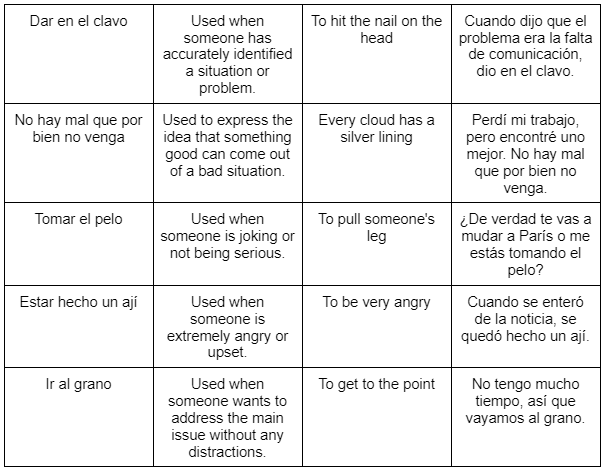
Everyday Conversational Idioms
In daily life, idiomatic expressions add colour and depth to language, making conversations more engaging and meaningful.
The same is true for Spanish. Mastering everyday idioms can help you sound more like a native speaker and communicate more effectively.
Below are some common idioms often heard in casual conversations among Spanish speakers. Learning these will give you valuable insights into the culture and everyday life of Spanish-speaking people.
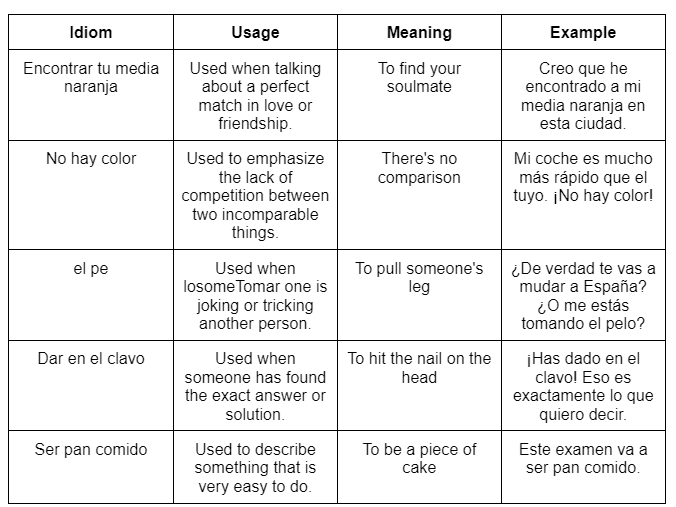

Regional Spanish Idioms
Understanding idioms that are distinct to particular countries or regions in the Spanish-speaking world can deepen your grasp of the language and culture.
For instance, in Spain, idioms like “Estar como una cabra” (to be crazy) or “No tener pelos en la lengua” (to not mince words) are common.
Argentina, too, has its unique set of idioms. Terms like “estar al pedo” (to be bored) and “estar en las nubes” (to be daydreaming) are often heard.
Learning these regional idioms can better your communication with native speakers and offer insight into the local customs and traditions.
Here’s a table of idioms unique to different Spanish-speaking regions:
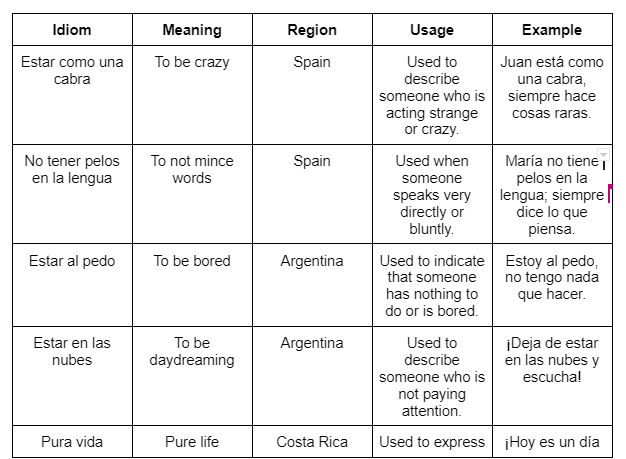
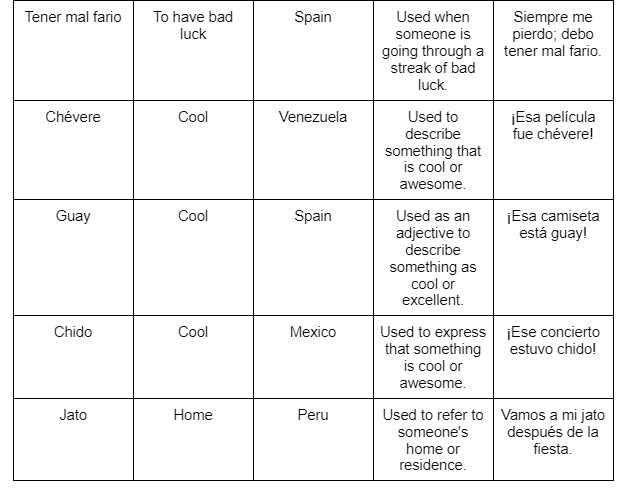
Funny and Quirky Spanish Idioms
Spanish idioms are not always serious. Some of them are playful and add a touch of humor to conversations.
For instance, the idiom “no ver tres en un burro” literally translates to “can’t see three [people] on a donkey,” but it really means to have bad eyesight.
Another quirky saying is “Matar la gallina de los huevos de oro,” which implies ruining a good opportunity. Idioms like “la tortilla” enrich the Spanish language, making it diverse and fun.
Knowing the right context to use these humorous idioms is key. Like the idiom “Estar de mala leche,” which literally means “to be in bad milk,” but it is used to describe someone who is in a foul mood.
Mastering these idioms not only entertains your Spanish-speaking pals but also shows your skill in the language and your grasp of its culture.
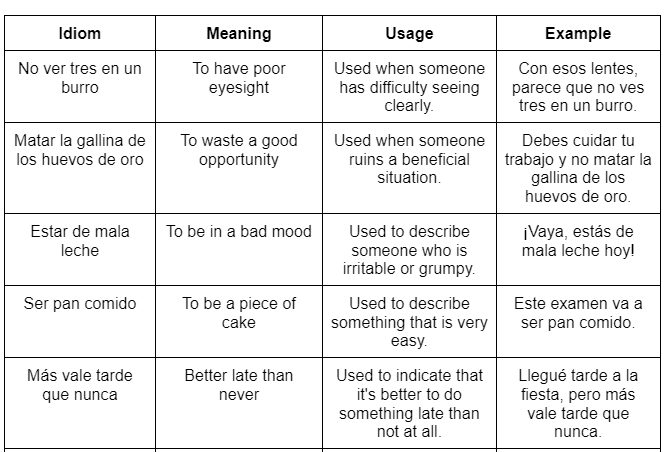
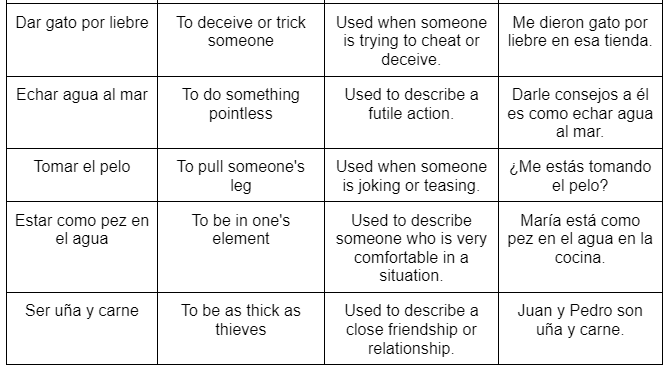
Tips for Incorporating Spanish Idioms into Conversations
Using Spanish idioms correctly can make your speech sound more like that of a native speaker. The key is to practice them in the right context and to know the cultural backdrop they come from.
Below are some tips that can help you incorporate idioms effortlessly into your conversations.
Practice with Native Speakers:
Engage in conversations with native Spanish speakers. You can use online platforms or join language exchange programs.
Start Small:
Begin with a few idioms and use them in your daily chats. This will make you more comfortable with their usage and meanings.
Special Occasion Idioms:
Learn idioms that are suitable for special events or holidays. This will add a unique cultural touch to your talks.
Master the Basics First:
Make sure you’re confident in basic Spanish phrases. This foundation will make it easier to insert idioms naturally into conversations.
Region-Specific Idioms:
Spanish idioms can differ from one country to another. If you’re focusing on a specific region, learn the idioms that are commonly used there.
By following these tips, you’ll not only enrich your vocabulary but also get closer to mastering the art of conversational Spanish.
Learning Spanish Idioms through Media
Utilizing media like movies, TV shows, and music can be a fun and impactful way to enhance your grasp of Spanish idioms.
These forms of media present idiomatic expressions in natural settings, helping you comprehend their meaning and usage better.
Here’s How to Do It:
Subtitles Are Your Friends:
Begin by watching Spanish movies or TV shows with English subtitles. This will allow you to correlate the idiomatic phrases with their meaning in real-time.
Tune into Podcasts:
Listening to Spanish podcasts can be another effective way. Start with slower-paced shows and gradually move to faster ones as you get comfortable.
Switch it Up:
Once you feel you’ve gotten the hang of it, try turning off the subtitles. This will force you to rely solely on your understanding of the language.
Repetition is Key:
Rewatching or relistening will reinforce your learning. Each time, you’re likely to pick up new idioms or better understand ones you’ve heard before.
Use a Notepad:
While consuming media, keep a notepad handy to jot down new idiomatic expressions. Later, you can review and practice them.
Recommended Media Sources:
Movies:
- El secreto de sus ojos (The Secret in Their Eyes)
- Todo sobre mi madre (All About My Mother)
- Ocho apellidos vascos (Spanish Affair)
- Relatos salvajes (Wild Tales)
- Parasite (2019)
TV shows:
- La casa de papel (Money Heist)
- Élite
- Narcos
- Luis Miguel: La serie
- El juego del calamar (Squid Game)
Podcasts:
- Nadie sabe nada (Nobody Knows Anything)
- Entiende Tu Mente (Understand Your Mind)
- El arte de vivir (The Art of Living)
- Cafeína
- Hoy en día (Today)
Overcoming Common Challenges with Spanish Idioms
Mastering Spanish idioms can certainly feel like an uphill battle at times. But with the right strategies and a bit of determination, you can navigate these challenges. Here are some actionable tips for the most common difficulties learners face:
Dive into Regional Language: Since slang and idioms can differ widely across Spanish-speaking regions, pick a specific area you’re keen on and immerse yourself in its language and culture. Local newspapers, blogs, and social media accounts can be great resources.
Context is King: To get the hang of how idioms are used in everyday language, try practicing them in conversations with native speakers. This not only helps you understand the context but also the regional variations.
Use Mnemonics: For idioms that are hard to remember, create mnemonic devices or associate them with a vivid story or image. This makes recalling them much easier.
Regular Practice: Consistency is the name of the game. The more regularly you review and use idioms, the quicker you’ll internalize them.
With these practical and easy-to-follow tips, you’ll be well on your way to overcoming the complexities and nuances of Spanish idioms. Remember, the road to mastery is all about practice and exposure.
How Spanish Idioms Evolve Over Time
If you’re on a journey to master the Spanish language, it’s crucial to keep up with how idioms evolve. Spanish idioms are far from static.
They change and adapt over time to reflect current trends in culture, technology, and social attitudes. Think of idioms as a snapshot of what’s happening in society at any given moment.
As our world becomes increasingly interconnected, you’ll find that Spanish idioms can be influenced by other languages and global trends.
Likewise, social movements can inspire new idioms that suddenly become part of everyday conversations.
So, what does this mean for you as a language learner? It means staying updated on new idiomatic expressions will make you more adept at understanding and engaging in meaningful conversations with native speakers.
Trust me, keeping your finger on the pulse of evolving idioms will take your Spanish language skills to the next level.
📣 Ready to Speak Spanish Like a Native? 🇪🇸

Learn over 300 Spanish idioms that will elevate your language skills to the next level! Rated 5.0 out of 5, this course has already helped 59 students master Spanish idiomatic expressions.
🌟 What You Get:
2.5 hours of on-demand video 🎥
20 downloadable resources 📚
Access on mobile and TV 📱📺
Full lifetime access 🔄
Certificate of completion 🏆
✅ What You’ll Learn:
Use idioms in real conversations 🗨️
Boost your chances in DELE and SIELE exams 📝
Understand native Spanish speakers in movies and social events 🎬
⭐ Course Content:
· 10 short themed intro videos with some introductionary idioms, examples, images and music in the background.
· 10 themed video lessons, packed with some idioms, their origin, some examples and to make it more exciting, we have taken the liberty to add some funny anecdotes.
· PDF transcripts for each themed video lesson, so that you can then look over the content in detail later or while watching the video, ensuring you understand it and haven’t missed any key points.
· 10 themed written lessons, including all idioms, origin, examples and controlled, semi-controlled and free practice (including the answers).
🎓 Who Should Take This Course:
If you’re at least at a B1 Intermediate level 📊
If you’re preparing for official Spanish exams 📝
If you want to enrich your conversational Spanish 🗨️ so read about 29 Learn Spanish Blog Options You Must Bookmark Today.
🚀 Take your Spanish to the next level! Click the link to enroll today!
FAQs
What are Spanish idiomatic expressions?
Spanish idiomatic expressions are symbolic expressions that form part of the cultural identity of all social groups. They are known as expresiones idiomáticas and generally have a figurative meaning.
What is an example of a Spanish idiom?
The Spanish idiom “no ver tres en un burro” translates to “can’t see three [people] on a donkey” and is used to describe someone with bad eyesight – e.g. “Without my glasses I’m as blind as a bat!”
Why do we need to learn idioms?
Learning idioms allows us to better comprehend conversation in Spanish, demonstrating our knowledge of cultural context. This can help improve our conversational skills and impress native speakers.
What’s the difference between the literal and figurative meanings of Spanish idioms?
The literal meaning of Spanish idioms is their direct translation, while the figurative meaning is what the words actually imply in a given context.
How can I use Spanish idioms appropriately in different conversational contexts?
To use Spanish idioms appropriately in different conversational contexts, understand the cultural context and practice using them with native speakers or language partners.
Related Posts:

